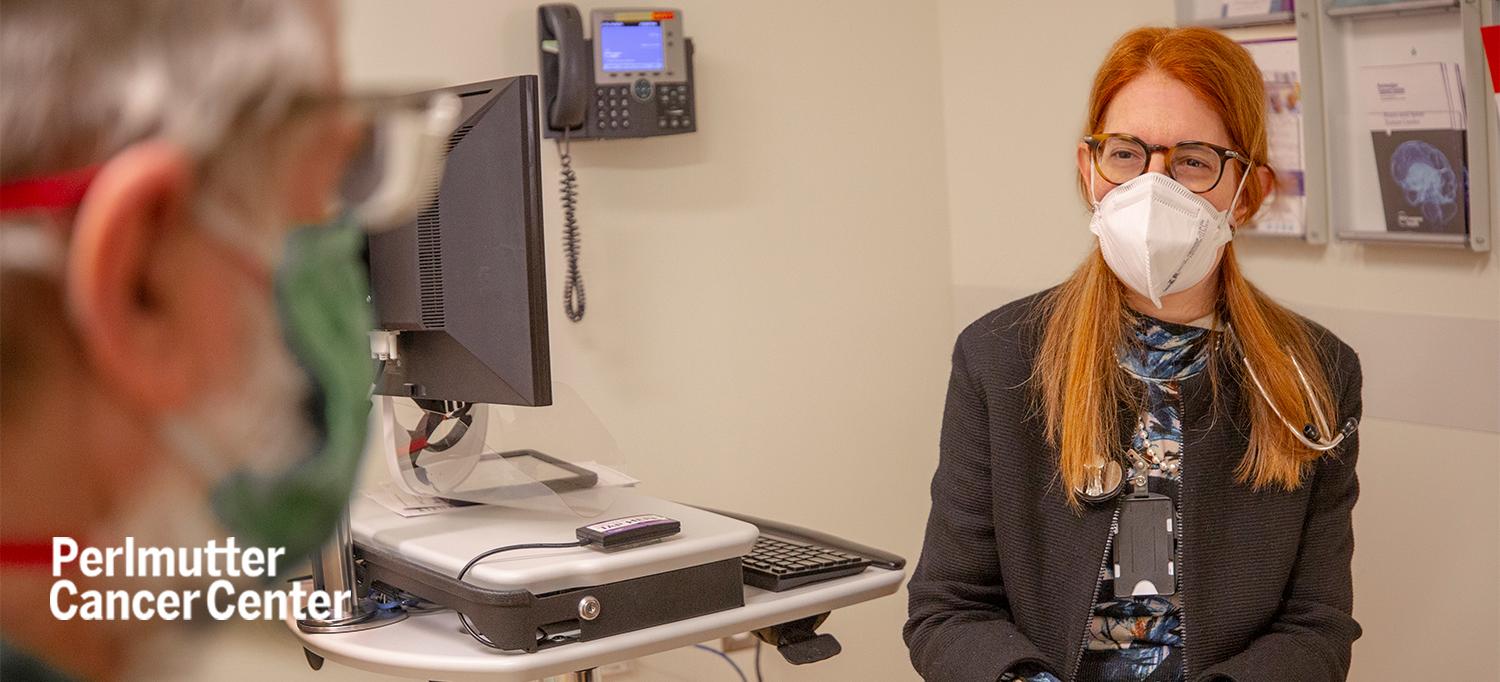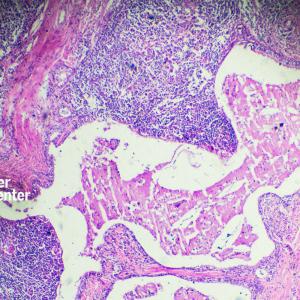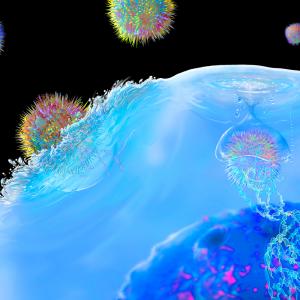
Dr. Catherine S. Diefenbach serves as the principal investigator for numerous lymphoma clinical trials.
Photo: NYU Langone Staff
Catherine S. Diefenbach, MD, associate professor in the Department of Medicine at NYU Grossman School of Medicine and director of the Clinical Lymphoma Program and director of hematology translational research at NYU Langone’s Perlmutter Cancer Center, is a hematologist–oncologist specializing in the care of people with lymphoma. Dr. Diefenbach, who directs the clinical lymphoma research program for the Division of Hematology and Medical Oncology, also serves as the principal investigator for numerous clinical trials at Perlmutter Cancer Center involving a range of different therapies, including chemotherapy, targeted therapy, and immunotherapy with novel antibodies and checkpoint inhibitors.
She discusses her current research, how she treats people with lymphoma, and more.
What research are you conducting now that you find particularly exciting?
From a translational standpoint, the project I’m most excited about is our study of the microbiome in aggressive lymphoma. The microbiome is the bacteria and viruses that live in your gut, and we have shown in a preliminary paper that the diversity of your microbiome—how many different species are present as well as the composition—may impact both the aggressiveness of lymphoma biology and a person’s response to subsequent treatment.
In collaboration with Dr. Jonas Schluter (assistant professor of microbiology at NYU Grossman School of Medicine) and Dr. Sergei B. Koralov (associate professor of pathology at NYU Grossman School of Medicine) and in partnership with the Mayo Clinic, we recently received a National Cancer Institute (NCI) R01 grant to launch a team science-based study. We are going to look at the association between microbial diversity and species composition with clinical outcome in patients with newly diagnosed diffuse, large B cell lymphoma (DLBCL), the most common aggressive lymphoma. We will follow changes in microbial diversity and species composition as people begin and proceed through treatment.
We will simultaneously investigate the impact of lymphoma treatment on microbiome signatures, particularly the impact of patients who are treated with prophylactic antibiotics and those who are not. We will also look both at how the microbiome might impact the response to treatment and how the treatment itself shapes the microbiome. And finally, we are looking at relationships between immune cell activation profiles and microbial diversity, and whether there may be crosstalk between the microbiome in the gut and the circulating immune system that impacts a patient’s ability to fight or not fight lymphoma. Ultimately, this research may lead to targeted, microbial-directed approaches to improve the efficacy of chemotherapy for patients with aggressive lymphoma such as DLBCL.
We also have parallel efforts to understand what effects antibiotics have on patients with lymphoma receiving anti-cancer therapy, particularly antibiotics for patients receiving immunotherapy. There are data already in the solid tumor space that antibiotic treatment may inhibit the response to checkpoint inhibitor therapy. I have initiated a large-scale investigation to examine this question within a large ongoing national NCI-sponsored trial of patients with relapsed Hodgkin lymphoma receiving checkpoint inhibitor therapy, which I lead. We are very excited to be able to investigate what the intersection is between the microbiome, bacteria, and viruses in the gut, and the immune system’s ability to evade or protect lymphoma.
What are some of the clinical trials you are involved in?
I also am involved in clinical research and in developing clinical trials that follow from scientific observations in the laboratory. One such trial that we are really excited about is a Hodgkin lymphoma trial that sprang from the observation that circulating immune cells in people with Hodgkin lymphoma have a phenotype that appeared chronically exhausted. That led to pioneering immunotherapy in the Hodgkin lymphoma space.
We have now published the results of a phase 1 study that was open throughout NCI’s Experimental Therapeutics Clinical Trials Network that looked at the combination of checkpoint inhibitor therapy with targeted chemotherapy, specifically brentuximab vedotin. That trial is now a randomized phase 2 trial throughout NCI’s National Clinical Trials Network, and we will hopefully be able to take a first look at the data for the first primary endpoint sometime this summer, so I’m very excited. That trial compares the doublet of brentuximab vedotin and nivolumab to the triplet of brentuximab vedotin, ipilimumab, and nivolumab. The adult cohort has completed accrual, and the pediatric patient accrual is ongoing.
How has the treatment of lymphoma changed in the last several years?
The integration of checkpoint inhibitor therapy in Hodgkin lymphoma care has completely changed the landscape of Hodgkin lymphoma. Before checkpoint inhibitor therapy and, even more strikingly, before brentuximab vedotin therapy, there were no new therapies in Hodgkin lymphoma in over 35 years. And first with the discovery of brentuximab vedotin, and then with the integration of checkpoint inhibitors into the care of relapsed Hodgkin lymphoma—which I helped to pioneer—there are now so many more treatment options for patients with relapsed Hodgkin lymphoma. Before the development of these therapies, patients who relapsed after autologous stem cell transplant might have a survival measured in months to a year. Patients, if they respond to checkpoint inhibitor therapy, are living for years and years. I have some patients in my phase 1 study who had relapsed after autologous or allotransplant who are still in remission now, five years out. So this has really changed the landscape of Hodgkin lymphoma.
Another development that I am particularly excited about in the lymphoma space is chimeric antigen receptor (CAR) T cells. CAR T cells are T cells that are taken out of the patient’s own body, trained to recognize tumor, and then reinfused. There are also off-the-shelf, or allogeneic, CAR T cells, and we are participating in a novel trial using off-the-shelf natural killer cells for aggressive lymphoma. Additionally, I am working with Dr. Neville Sanjana (assistant professor of neuroscience and physiology at NYU Grossman School of Medicine) and Dr. Mat Legut, a postdoctoral scientist in Dr. Sanjana’s lab and at the New York Genome Center, to develop a potential next-generation CAR T cell for aggressive lymphoma, which in vitro appears to have superior immune activation compared to commercial CAR T products.
What should a patient expect when they come to see you for treatment for lymphoma?
My first job is to reassure patients that in many cases, lymphoma is treatable and manageable, and these days often aggressive lymphoma is treatable. Before we even start to discuss treatment, I try to understand what the patient knows about the disease. There are over 68 subtypes of lymphoma, which is why it is important for people with lymphoma to be treated by oncologists who are experienced in the management of lymphoma. I explain to the patient that lymphoma is very heterogeneous and that we need to understand their specific biology to come up with a chemotherapy plan that fits their lymphoma and performance status. Even within DLBCL, there are significant nuances now with regard to treatment planning.
Once we have completed staging and reviewed pathology, we discuss treatment options. If they have an indolent lymphoma, we might discuss watchful waiting, if that is indicated. If they are newly diagnosed with an aggressive lymphoma, we will discuss standard therapy and whether they are eligible for any of the investigational studies we have open and why the investigational studies might be a reasonable option for them if they have a particularly high-risk biology that one of our studies is looking to explore. We have had patients come as far as Florida for some of our frontline clinical trials.
If a patient has relapsed disease, I discuss with them what therapies they received previously. Based on their biology, their previous treatments, and their fitness, we discuss which trials from our large portfolio would be appropriate to them, and which standard therapy approaches are appropriate. And then we make a plan going forward based on this discussion.
What is on the horizon for treating people with lymphoma?
I think we are going to get much better at targeting chemotherapy to lymphoma biology by understanding what drives lymphoma growth and therapy resistance. There is a lot of heterogeneity in lymphoma classifications, but I think we are going to start understanding tumors much more by mechanistic rather than histological categories. Also understanding how to sequence many of the newly approved or soon to be approved agents such as CAR T cells and bispecific antibodies—antibodies that target both a tumor cell target and an immune cell target—will be important.
I think in the upfront setting, we may be able to tailor chemotherapy better to the patient’s risk and minimize therapeutic toxicity further while exploring novel strategies for patients with high-risk features. Bispecific antibodies are an exciting class of new therapies with high activity and reasonable toxicity, and I have taken a leading role in studies investigating multiple antibodies in this class.
We are participating in a trial for frontline therapy of DLBCL examining integrating targeting a protein called BCL-2 with venetoclax as well as targeting the transmembrane protein CD79 with the antibody–drug conjugate polatuzumab vedotin now approved in frontline DLBCL into first line therapy.
We are also leading trials to evaluate bispecific antibodies. We have several of these trials open right now that we are leading that are showing very durable responses for patients with both aggressive and indolent lymphoma. I think this is going to be a development that is important in the future because it is much less toxic than CAR T cells, and it is a therapy that does not seem to be dependent on cell of origin and works well across most patient subgroups. I think next-generation CAR T cells, which may be able to salvage either higher numbers of patients or salvage patients with less toxicity, will also be exciting.
This is an exciting time to be a lymphoma researcher with so many new therapies and agents available to improve the quality of life, and often extend life for patients. None of this would be possible without the bravery of our patients, the dedication of our research and nursing staff, and the collaboration of our scientific partners.

